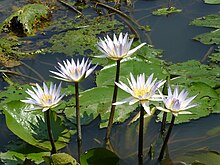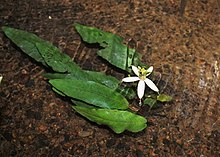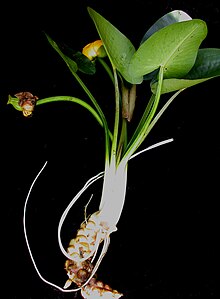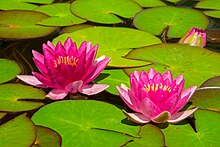Nymphaeaceae
This article may be too technical for most readers to understand. (May 2021) |
| Nymphaeaceae Temporal range: Early Cretaceous - Recent
| |
|---|---|

| |
| Nymphaea nouchali | |
| Scientific classification | |
| Kingdom: | Plantae |
| Clade: | Tracheophytes |
| Clade: | Angiosperms |
| Order: | Nymphaeales |
| Family: | Nymphaeaceae Salisb.[1] |
| Genera | |
|
Extant genera[2] Fossil genera
| |
| Synonyms[3] | |
| |




Nymphaeaceae (.
Water lilies are a well-studied family of plants because their large flowers with multiple unspecialized parts were initially considered to represent the floral pattern of the earliest flowering plants. Later genetic studies confirmed their evolutionary position as
Description
The Nymphaeaceae are aquatic,
Leaves are alternate and spiral, opposite or occasionally whorled, simple,
Flowers
Flowers are solitary, bisexual, radial, with a long pedicel and usually floating or raised above the surface of the water, with girdling vascular bundles in
There are 4–12
Fruit
The fruit is an aggregate of nuts, a berry, or an irregularly dehiscent fleshy spongy capsule.[7] Seeds are often arillate, more or less lacking endosperm.
Taxonomy

Nymphaeaceae has been investigated systematically for decades because botanists considered their floral morphology to represent one of the earliest groups of
Nymphaeaceae is a small family of three to six genera:
The
Fossils
Several fossil species are known, including
As an invasive species
The beautiful nature of water lilies has led to their widespread use as
Culture

The
The Nymphaeaceae, which is also called (Nilufar Abi in Persian), can be seen in many reliefs of the Achaemenid period (552 BC) such as the statue of
Lily pads, also known as Seeblätter, are a charge in Northern European heraldry, often coloured red (gules), and appear on the flag of Friesland and the coat of arms of Denmark (in the latter case often replaced by red hearts).
The water lily has a special place in Sangam literature and Tamil poetics, where it is considered symbolic of the grief of separation; it is considered to evoke imagery of the sunset, the seashore, and the shark.
Heraldry
-
The emblem of , (1756–1837).
-
Personal coat of arms of Cyril Newall, 1st Baron Newall (1946)
-
National Emblem of Bangladesh (1972–present)
-
Coat of arms ofOurense.
In visual arts
Water lilies were depicted by the
The Maya

The main job of the
The Maya began to use water lily iconography depicted on
Gallery
-
Lily pads floating in a lake in Toronto, Canada
-
Lily pads floating on Matkusjoki River in Iisalmi, Finland
-
Water lily at Sambalpur
-
Water Lilies, 1920-1926, Musée de l'Orangerie
-
Nuphar pumila 2014 in China
-
Time-lapse video of a water lily blooming
-
Water lily blooming in Sankarpur of West Bengal
-
Blue water lily of Bangladesh
-
Yellow water lilies in Wales, 2021
See also
- Nelumbo
- Pamplemousses Botanical Garden, famous for its giant water lilies
- List of plants known as lily
References
- ^ hdl:10654/18083
- ^ "Nymphaeaceae Salisb". Plants of the World Online. Royal Botanic Gardens, Kew. Retrieved 22 July 2023.
- ^ Nymphaeaceae. (n.d.). GBIF | Global Biodiversity Information Facility. Retrieved August 4, 2023, from https://www.gbif.org/species/103019924
- ^ "Nymphaeaceae Salisb. Ann. Bot. (König & Sims) 2: 70. 1805. (Jun 1805)". World Flora Online. The World Flora Online Consortium. 2022. Retrieved 13 July 2022.
- .
- ^ a b Phylogeny, Classification and Floral Evolution of Water Lilies (Nymphaeaceae; Nymphaeales): A Synthesis of Non-molecular, rbcL, matK, and 18S rDNA Data, Donald H. Les, Edward L. Schneider, Donald J. Padgett, Pamela S. Soltis, Douglas E. Soltis and Michael Zanis, Systematic Botany, Vol. 24, No. 1, 1999, pp. 28-46
- ^ a b c "Family: Nymphaeaceae (water-lily family): Go Botany". gobotany.nativeplanttrust.org. Retrieved 2021-05-07.
- S2CID 2037133.
- S2CID 89844294.
- ISSN 0367-2530.
- JSTOR 2399367.
- ^ ISSN 0024-4074.
- ^ a b As easy as APG III - Scientists revise the system of classifying flowering plants, The Linnean Society of London, 2009-10-08, retrieved 2009-10-29
- ^ a b APG III tidies up plant family tree, Horticulture Week, 2009-10-08, retrieved 2009-10-29
- ^ Mario Coiro & Maria Rosaria Barone Lumaga (2013): Aperture evolution in Nymphaeaceae: insights from a micromorphological and ultrastructural investigation, Grana, DOI:10.1080/00173134.2013.769626
- ^ Insights into the dynamics of genome size and chromosome evolution in the early diverging angiosperm lineage Nymphaeales (water lilies), Jaume Pellicer, Laura J Kelly, Carlos Magdalena, Ilia Leitch, 2013, Genome, 10.1139/gen-2013-0039
- Soltis PS, Soltis DE, Zanis M (1999) Phylogeny, classification and floral evolution of water lilies (Nymphaeaceae; Nymphaeales): a synthesis of non-molecular, rbcL, matK, and 18S rDNA data. Systematic Botany 24: 28–46.
- ^ Löhne C, Wiersema JH, Borsch T (2009) The unusual Ondinea, actually just another Australian water-lily of Nymphaea subg. Anecphya (Nymphaeaceae). Willdenowia 39: 55–58.
- ^ Löhne C, Borsch T, Wiersema JH (2007) Phylogenetic analysis of Nymphaeales using fast-evolving and noncoding chloroplast markers. Botanical Journal of the Linnean Society 154: 141–163.
- ^ Borsch T, Löhne C, Wiersema J (2008) Phylogeny and evolutionary patterns in Nymphaeales: integrating genes, genomes and morphology. Taxon 57: 1052–1081.
- ^ Dkhar J, Kumaria S, Rama Rao S, Tandon P (2012) Sequence characteristics and phylogenetic implications of the nrDNA internal transcribed spacers (ITS) in the genus Nymphaea with focus on some Indian representatives. Plant Systematics and Evolution 298: 93–108.
- S2CID 86651676.
- S2CID 84253809.
- S2CID 23846066.
- ^ Gee, C. T., & Taylor, D. W. (2019). "An Extinct Transitional Leaf Genus of Nymphaeaceae from the Eocene Lake at Messel, Germany: Nuphaea engelhardtii Gee et David W. Taylor gen. et sp. nov." International Journal of Plant Sciences, 180(7), 724-736.
- ^ Taylor, W., DeVore, M. L., & Pigg, K. B. (2006). "Susiea newsalemae gen. et sp. nov.(Nymphaeaceae): Euryale-like seeds from the Late Paleocene Almont Flora, North Dakota, USA." International Journal of Plant Sciences, 167(6), 1271-1278.
- ^ "Nyphaea genus". www.cdfa.ca.gov. Retrieved 2018-09-13.
- doi:10.3390/w3020479.
- ISBN 978-0-12-322050-9.
- ^ S2CID 55165881.
- . Retrieved 28 April 2023.
Further reading
- The genera of the Nymphaeaceae and Ceratophyllaceae in the southeastern United States. J. Arnold Arbor. 40: 94-112.
- Perry D. Slocum: Waterlilies and Lotuses. Timber Press 2005, )
- Thomas Borsch, Cornelia Löhne, Mame Samba Mbaye, and John H. Wiersema. 2011. Towards a complete species tree of Nymphaea: shedding further light on subg. Brachyceras and its relationships to the Australian water-lilies. Telopea 13(1-2): 193-217.
- Taylor, David Winship; Gee, Carole T. (1 October 2014). "Phylogenetic Analysis of Fossil Water Lilies Based on Leaf Architecture and Vegetative Characters: Testing Phylogenetic Hypotheses from Molecular Studies". Bulletin of the Peabody Museum of Natural History. 55 (2): 89–110. S2CID 84253809.












